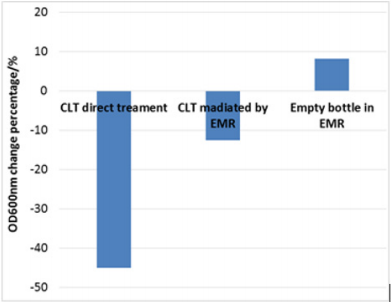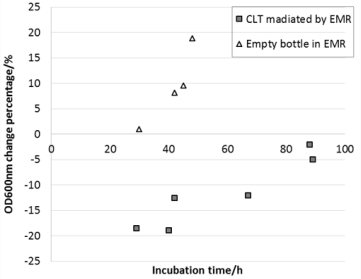Abstract
Clotrimazole (CLT) is an antimycotic medicine widely used in the treatment of yeast infections. In the present study, we investigated the effect of CLT mediated by electromagnetically resonance (EMR) on the growth of Saccharomyces cerevisiae. The growth of the yeast cells was obviously influenced by EMR mediated CLT with an inhibition ratio of 12.6% when incubated for 42h, and the ratio decreased along with the cultivation time. On the other hand, the EMR without CLT promote the growth of yeast to 8.2% at 42h and the promotion effect increased with the cultivation time. Our research demonstrates the non-contact, or remote effects of electromagnetic field mediated CLT, and the time dependent characteristics.
Keywords: Clotrimazole; S. cerevisiae; Growth; Electromagnetically resonance
Abbreviations: CLT: Clotrimazole; EMR: Electromagnetically Resonance; DDS: Direct Digital Synthesizer; OD: Optical Density; CD: Coherent Domains
Introduction
The yeast S. cerevisiae has 31% gene homology with mammalian, and many metabolic pathways are same in the two species. It is recognized as a useful modal organism for biological studies [1]. Clotrimazole (CLT) is commonly used in the treatment of fungal infections. CLT inhibit the biosynthesis of ergosterol [2] whose depletion will perturb normal membrane permeability and fluidity [3]. Meanwhile, CLT treatment could also induce apoptosis death in S. cerevisiae [4]. There are many researches paying attention to the effect of active molecules mediated by electromagnetic signals on the target cells. Different active agents were attempted to transmit to different targets to act as the original chemical molecule, such as acetic acid [5], Metronidazole [6], Amphotericin B [7], retinoic Acid [8], Phorbol-myristate acetate [9] and even bacterial DNA sequences [10]. In this paper, we studied the growth of S. cerevisiae influenced by electromagnetically resonance (EMR) mediated CLT and evaluated the effect on the yeast at different incubation time.
Materials and methods
Strain and Media
Industrial instant dry yeasts S. cerevisiae (5g*400/F, ANGEL YEAST CO. LTD., China) were in rich medium YPD (2% tryptone, 1% yeast extract, 2% D-(+)-glucose, and optionally 2% agar).
Electromagnetically Resonance (EMR) Apparatus
The EMR apparatus consists of two standard pancake Tesla coils being made on printed circuit board that functioning as a transmitter and a receiver respectively. The secondary coil is printed on the top of the printed circuit board with 16 meters total length, 0.5mm width and 0.5mm space between two wires. The centre of the secondary coil is connected to a stainless-steel ball of 120mm diameter. A ground wire is used to link the transmitter and receiver coil connecting the outside end of the secondary coil. The primary coil is printed under the printed circuit board with the same width and space, but shorter length [11] and connected directly to the DDS (Direct Digital Synthesizer) generator, whose output impedance is usually under 10 Ohms. When the two coils meet the condition of same frequency, same wave shape and opposite phase shift, self-resonance of the whole system will be generated. In our experiments, the resonant frequency varied between 3.2 and 3.6 MHz due to the field attenuation by the agar plates and the glass bottles containing the drug powder.
Experimental Procedures
Glass bottle with or without CLT powder was placed on the transmitter coil respectively. The logarithmic phase S. cerevisiae cells were diluted with YPD to 2 x 104 cells/ml and 100uL sample was seeded on the 60mm agar plate. Triplicate plates were placed on the receiver coil, whereas another triplicate plate was placed out of the EMR field and served as the control. CLT was added into the diluted sample at a final concentration of 5mg/L and immediately plated in the dishes as the direct drug treatment group. After different times of incubation, all yeast cells of each dish were washed down with sterilized deionized water to the same volume for the optical density (OD) measurement at 600nm (UV-2800, UNICO, shanghai, China) and the change percentage was calculated compared to the control, which was evaluated as: OD 600nm change percentage = (OD sample/ODcontrol-1)×100%.
Result
Growth of Yeast Under Direct and Mediated CLT
The growth of S. cerevisiae in the EMR field with CLT or empty bottle and being directly treated by CLT was evaluated compared to the control. It could be seen that the direct addition of CLT strongly inhibited the growth of yeast which resulting in a 45% inhibition ratio at 42h. On the other hand, the inhibition rates obtained by mediated CLT reached 12.6% which is about a quarter as effective as direct drug application. Whereas the EMR without drug (empty bottle) promoted the growth of S. cerevisiae to 8.2% increase (Figure 1).
Figure 1: OD 600nm change percentage of the yeast for different treatment. Each group was in triplicate.
Time Dependent Effect on the Growth of Yeast
As the 42h incubation in the EMR field with or without CLT apparently influenced the growth of S. cerevisiae, the effects of different incubation time were studied. It turned out to be that the effects of mediated CLT and EMR field (empty bottle) were time dependent (Figure 2). The inhibition effect of mediated CLT achieved about 18% at 30-40h and decreased along with the incubation time. Whereas the promotion effect of EMR field increased as the cultivation time extended and achieved 19% at 48h.
Figure 2: OD 600nm change percentage of the yeast cells at different incubation time with or without CLT. Each group was in triplicate.
Discussion
As the EMR field promoted the growth of S. cerevisiae, it can be concluded that the mediated CLT inhibited the yeast growth efficiently. The inhibition effect of mediated CLT decreased probably due to the promotion effect of EMR field increased and the increase of the cells. We found that frequencies between 3.1-3.9MHz improved the yeast cell activity (data not shown), and maybe this is the reason for the promotion effect of the EMR. Our research demonstrates the non-contact, or remote effects of electromagnetic field-mediated CLT, and the time dependent characteristics. The distant non-chemical communication may provide an optional way to utilize medicine due to its non-invasive nature, local application, and cost-effectiveness.
How the chemical agents being transduced to the target systems, the mechanisms are remained unknown. Most researchers believe that the drug electromagnetic signals resonant with the frequencies of the coherent domains (CD) of water which induce a dipole moments reconstruction. Finally, the drug information could be stored, translated and transferred by the water structure of the aqueous systems toward the biological target and selectively modulating their activity [12,13]. Although many studies revealed that the active molecules in electromagnetic field influenced the growth and other features of biological targets through distant non-chemical communication, there is still no direct proof for whether the drug information is indeed transmitted, and further study is required. Next, we’ll study the apoptotic markers and component variation of the cells being incubated in the EMR mediated CLT. This is helpful to discuss whether the distant nonchemical communication have the same effect on the yeast as the direct addition of CLT.
Acknowledgement
This work was supported by ENN Group.

 Short Communication
Short Communication

